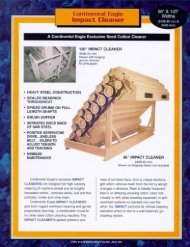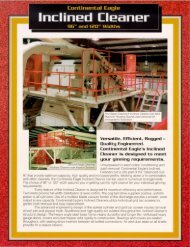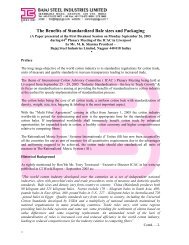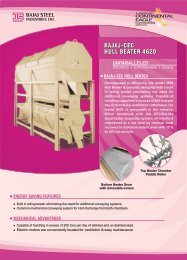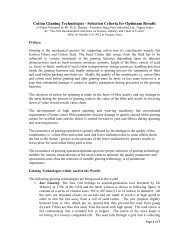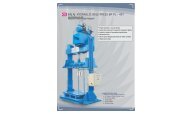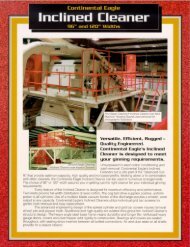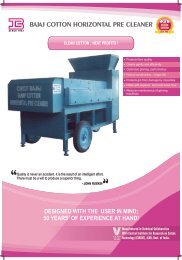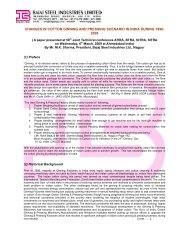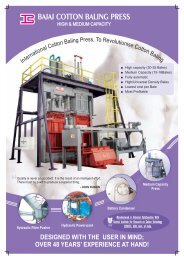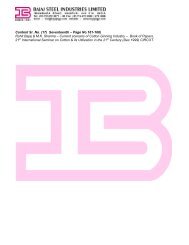recent advances in ginning for lowering cost and ... - Bajaj Group
recent advances in ginning for lowering cost and ... - Bajaj Group
recent advances in ginning for lowering cost and ... - Bajaj Group
Create successful ePaper yourself
Turn your PDF publications into a flip-book with our unique Google optimized e-Paper software.
(RECENT ADVANCES IN GINNING FOR LOWERING COST AND IMPROVING OF EFFICIENCY)<br />
# 4 #<br />
3.3.2 Rotobar G<strong>in</strong><br />
The Rotobar g<strong>in</strong> is shown <strong>in</strong> Figure 3.4 (a). It works on the same pr<strong>in</strong>ciple as the roller g<strong>in</strong> as shown <strong>in</strong> Figure<br />
3.4 (b). It has a rotat<strong>in</strong>g <strong>in</strong>stead of oscillat<strong>in</strong>g beater bar, <strong>and</strong> is expected to give higher amount of l<strong>in</strong>t per<br />
hour, per mach<strong>in</strong>e. The rotary knife vibrates less due to rotary motion <strong>and</strong> is more efficient than the<br />
reciprocat<strong>in</strong>g knife, which wasted time dur<strong>in</strong>g backstroke. G<strong>in</strong>n<strong>in</strong>g rate <strong>and</strong> carryover (ung<strong>in</strong>ned seed cotton<br />
that accompanies the seed) <strong>in</strong>crease with feed rate. The ma<strong>in</strong> components of rotary knife roller g<strong>in</strong> st<strong>and</strong><br />
<strong>in</strong>clude the stationary knife, rotary knife <strong>and</strong> g<strong>in</strong>n<strong>in</strong>g roller. The g<strong>in</strong>n<strong>in</strong>g roller is the most important <strong>and</strong><br />
expensive component <strong>in</strong> the Rotobar G<strong>in</strong> St<strong>and</strong>. Roller cover<strong>in</strong>g material is made from 13 layers of pla<strong>in</strong><br />
woven cotton fabrics cemented together with rubber compound.<br />
Rotary-knife roller g<strong>in</strong> st<strong>and</strong>s separate fibre from seed by frictional <strong>for</strong>ces between a mov<strong>in</strong>g (roller) <strong>and</strong> fixed<br />
(stationary knife) surface. Three frictional <strong>for</strong>ces exist while roller g<strong>in</strong>n<strong>in</strong>g cotton: (i) roller-to- stationary knife<br />
(ii) roller-to-fibre <strong>and</strong> (iii) stationary knife- to-fibre. Dur<strong>in</strong>g normal g<strong>in</strong>n<strong>in</strong>g, the roller-to-fibre <strong>for</strong>ce is greater than<br />
the stationary knife- to-fibre <strong>for</strong>ce; there<strong>for</strong>e, the fibre sticks to the roller surface <strong>and</strong> slips to the stationary<br />
knife surface. Also, greater the <strong>for</strong>ce between the stationary knife <strong>and</strong> g<strong>in</strong>n<strong>in</strong>g roller, the greater the frictional<br />
pull<strong>in</strong>g <strong>for</strong>ce between the fibre <strong>and</strong> g<strong>in</strong>n<strong>in</strong>g roller.<br />
Figure 3.3.2 (a) Rotobar G<strong>in</strong><br />
Figure 3.3.2 (b) Pr<strong>in</strong>ciple of operation<br />
Cotton is g<strong>in</strong>ned at the rate the cotton fibres (adhered to the roller surface) slip under the stationary knife.<br />
Overfeed<strong>in</strong>g or feed<strong>in</strong>g <strong>in</strong> bunches causes fibre <strong>and</strong> seed to entangle with each other <strong>and</strong> g<strong>in</strong>n<strong>in</strong>g<br />
per<strong>for</strong>mance gets adversely affected. Although rotary knife roller g<strong>in</strong> is advanced version of roller g<strong>in</strong>, these<br />
g<strong>in</strong>s have not yet found wide application <strong>in</strong> g<strong>in</strong>n<strong>in</strong>g <strong>in</strong>dustry due to disadvantages of ung<strong>in</strong>ned cotton go<strong>in</strong>g<br />
with seed <strong>and</strong> seed cuts etc. apart from its limitation to g<strong>in</strong> long <strong>and</strong> extralong fibres only.<br />
3.3.3. Double Roller G<strong>in</strong><br />
In a double roller (DR) g<strong>in</strong>, two spirally grooved leather rollers, pressed aga<strong>in</strong>st two stationary knives with the<br />
help of adjustable dead loads, are made to rotate <strong>in</strong> opposite directions at a def<strong>in</strong>ite speed. The three beater<br />
arms (two at end <strong>and</strong> one at the center of beater shaft) are <strong>in</strong>serted <strong>in</strong> the beater shaft <strong>and</strong> two knives<br />
(mov<strong>in</strong>g knives) are then fixed to the beater arms with proper alignment. This assembly is known as beater<br />
assembly, which oscillates by means of a crank or eccentric shaft, close to the leather roller. When the seed<br />
cotton is fed to the mach<strong>in</strong>e <strong>in</strong> action, fibres adhere to the rough surface of the roller <strong>and</strong> are carried <strong>in</strong><br />
between the fixed knife <strong>and</strong> the roller such that the fibres are partially gripped between them. The oscillat<strong>in</strong>g<br />
knives (mov<strong>in</strong>g knives) beats / drags the seeds from top to opposite direction caus<strong>in</strong>g separation of fibres<br />
from the seed end. This process is repeated a number of times till all sp<strong>in</strong>nable fibres are separated from the<br />
Contd. …5.



